How Has The Application Of Solar Energy Technology
Improved Over The Years?
It needed to happen.
A new appreciation for the principles of solar thermodynamics has produced higher efficiency, greater performance, improved appearance and better return on the solar investment.
|
Bad Old Days
|
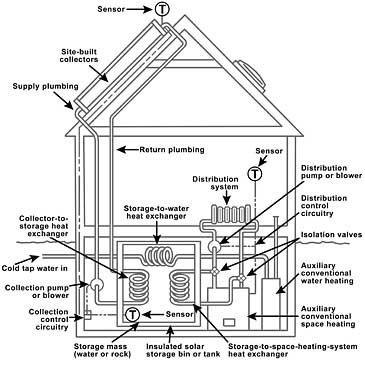 |
|
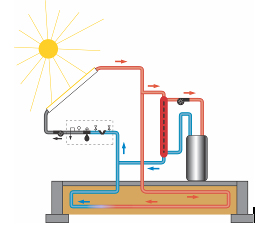
Improved Design |
FUNDAMENTAL PRINCIPLESIf we want to use solar energy effectively,
|
|
Low temperatures - The second law of thermodynamics literally tells us that heat moves from hot to cold. The corollaries or related implications of this law tell us much more.
Heat always wants to go somewhere else, and it will go there if it can. - Anything that is warmer than its environment is going to lose heat. Solar collectors lose heat to the outside air when they are running too hot and that heat loss lowers efficiency. This means that for the sake of efficiency, we must use the sun's energy at the lowest possible temperature. Standard solar thermal collectors will harvest about 78% of the sun's energy at the relatively low temperatures of 75°F. The same solar collector will harvest nothing at all at an operating temperature of 220°Fand all of the heat will go into the air. We must carefully look at the task and then design our systems to operate as close to the minimum temperature as possible. For example, if we want to provide space heating for our building, that temperature is about 72°F and we should be trying to operate our systems closely to that. High temperatures in a solar heating system are not a good thing.
| Any intelligent fool can make things bigger and more complex... It takes a touch of genius to move in the opposite direction.
-Albert Einstein |
Simplicity - A lot of wisdom informs us that we should strive for simplicity. Another scientific principle called Occam's razor, suggests that if there are multiple choices to explain a phenomenon, the simplest choice is preferred. While this is technically a scientific investigation principle, it is widely accepted advice in applied technology. It supports the K.I.S.S. principle (Keep it simple stupid.) Every time you change heat from one form to another or move it from one place to another, you will lose some along the way. This means that unnecessary heat exchangers raise temperatures, lose energy and lower efficiency. Simplicity reduces complexity, lowers cost and increases reliability and safety. We must be absolutely ruthless about keeping our solar heating systems as simple as possible.
Integral Storage - It makes sense to use what is already in the building for heat storage. This is the "passive solar heating" logic. According to the Second Law, anything that is warm will lose heat. Let your solar thermal heat storage lose its heat within the building envelope. We know of many solar designs that used a large outside tank for thermal storage. Nearly all of the heat is lost to the ground outside of the building.
Quality - The proven performance of solar heating systems has given rise to a new emphasis on quality. A solar heating system can and should be designed to last the life of the building.
|
You can't always get what you want...
No you can't always get what you want, But if you try real hard you might find... You get what you need. -Mick Jagger |
Realistic goals - Solar heating design had been burdened by the incorrect notion that the solar heating system needed to provide 100% of the load or else "it didn't work". The result was architectural extremism where "an acre of solar panels" was contemplated in order to provide a 100% solar heating fraction under extreme conditions.
Now, we know better. As an analogy, if you need $10, and you see $5 laying on the ground, do you pick it up or do you continue along? Only a fool would fail to take advantage of what is readily available for free and then go looking for the remainder.
Here we speak to the smaller solar heating systems that provide domestic hot water plus some supplemental radiant heat or snow melting or other use. There is very limited architectural impact and cost effectiveness can be good.
RADIANT HEATING
Underfloor radiant heating is enjoying resurgence in popularity because of its comfort and energy efficiency. The sun is the mother of all radiant heating systems and its partnership with mechanical, earthly underfloor radiant systems is a natural thing. There are many benefits to this combination, and this appreciation has taken the practice of solar heating design to an entirely new level. Visit our Solar Options page for more information about radiant underfloor heating and solar energy.
UNEXPECTED BENEFITS
The thermodynamic advantages of combining radiant heat with solar energy are a little subtle. Nevertheless, the layman can appreciate these advantages with a little study. Visit our Unexpected Benefits page for a technical description of these advantages. You will see how this combination is a breakthrough in solar heating that offers much greater efficiency with lower cost.
UTILIZATION
It stands to reason that when the sun comes out, you have to use it, or there will be little benefit. The more productive uses for a solar energy system, the better!

Lots of domestic hot water |
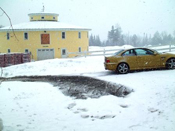
Snowmelting |
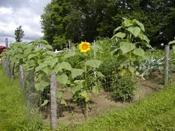
|
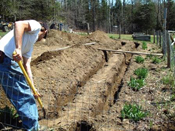
|
| Solar powered gardening... | |
Root zone heating extends the season and increases productivity.
ARCHITECTURAL FLEXIBILITY
Better efficiency means that fewer solar collectors are needed to do the job and they do not necessarily have to go on the building. Consider these options as well.
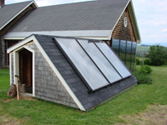 On a wood shed |
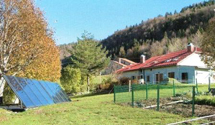 as a fence or windbreak |
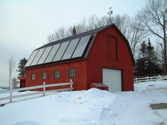 On a garage |
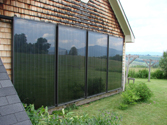 Vertical |
AFFORDABILITY
An important improvement is that solar can now be affordable. Solar is no longer just for the wealthy.
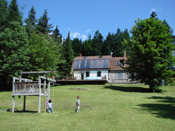
Rural solar |
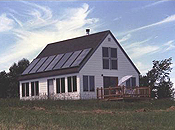
Solar housing development |
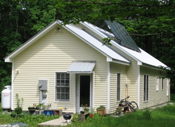
Habitat for Humanity project |
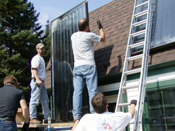
Do it yourself project |
|
Concern for man and his fate must always form the chief interest of all technical endeavors. Never forget this in the midst of your diagrams and equations.
- Albert Einstein
When the solution is simple, God is answering. - Albert Einstein
|
Our solar technicians are always ready to answer questions.
Call 1-800-451-7593



